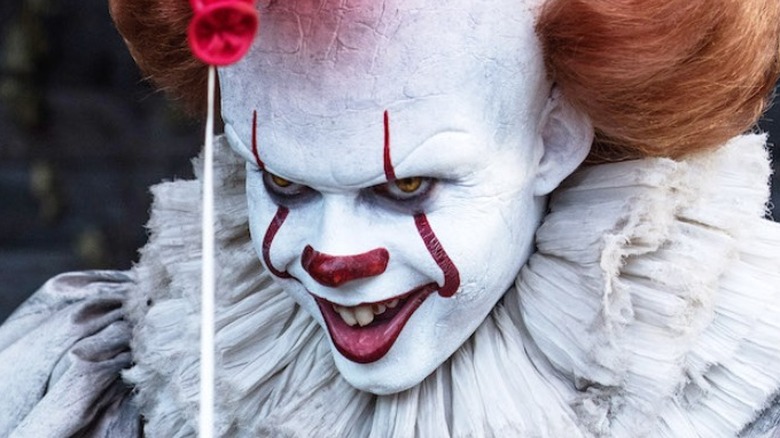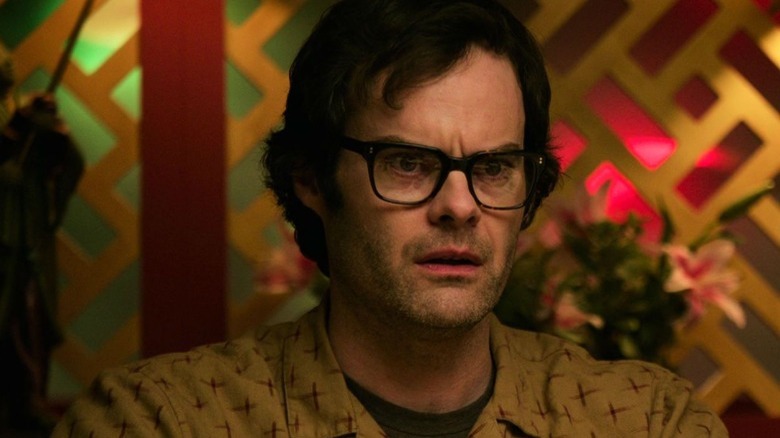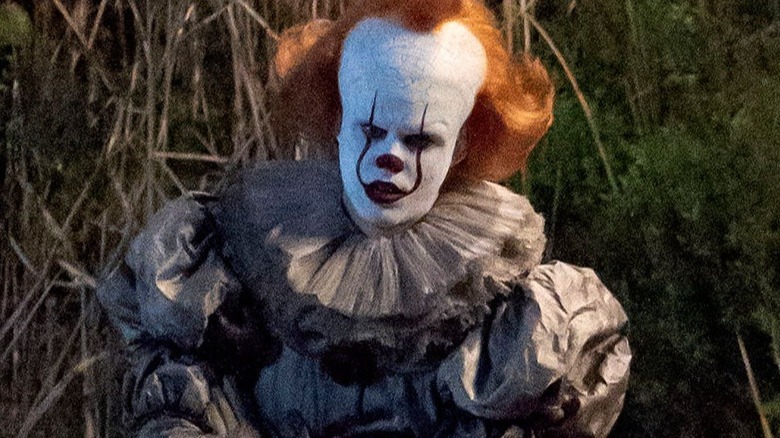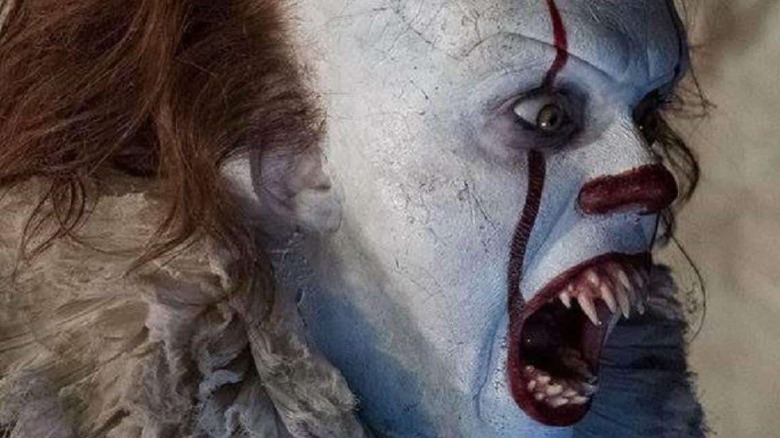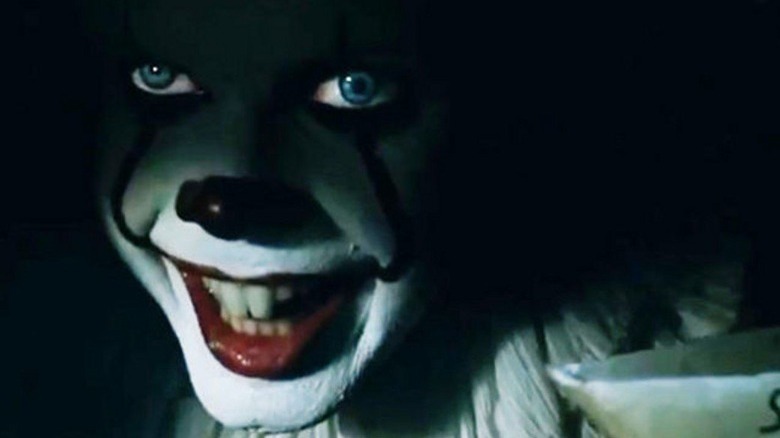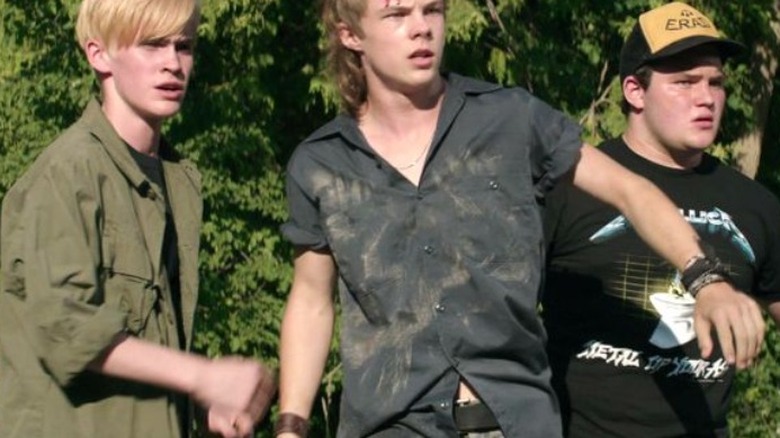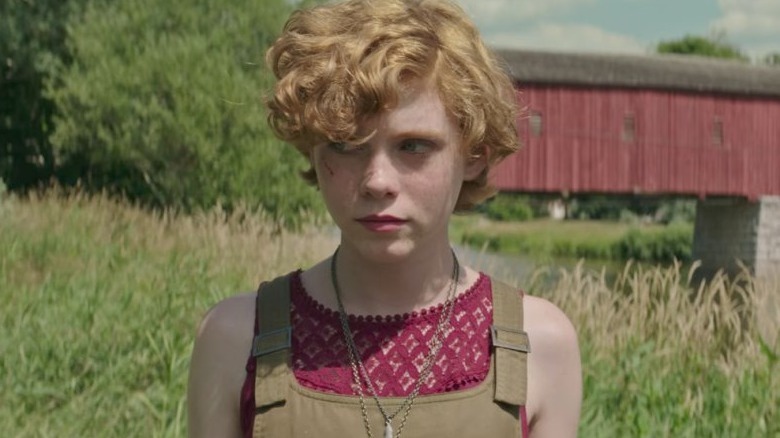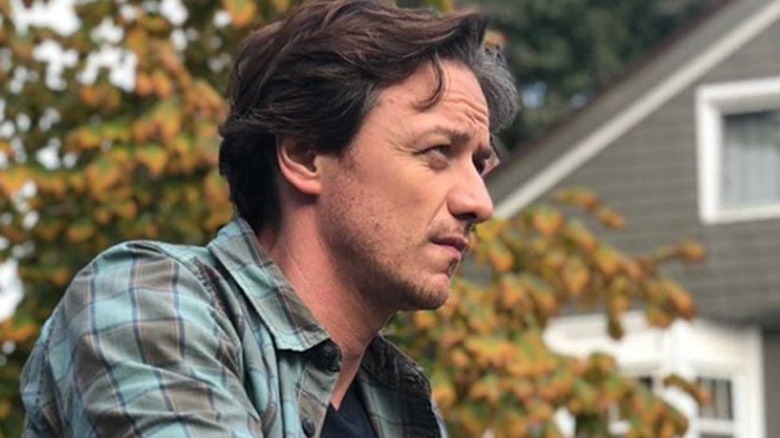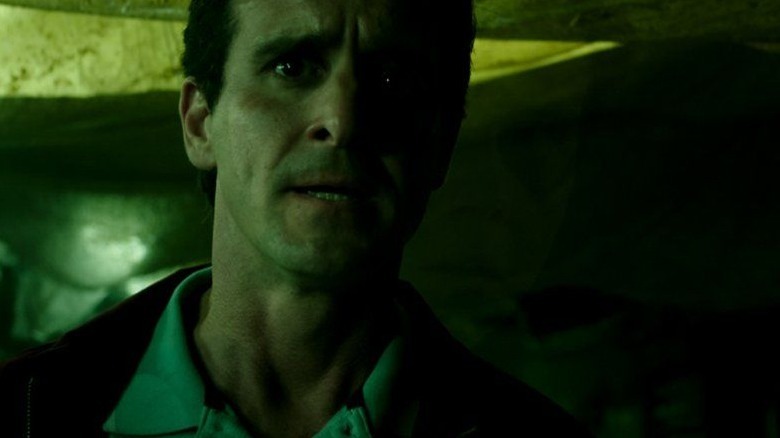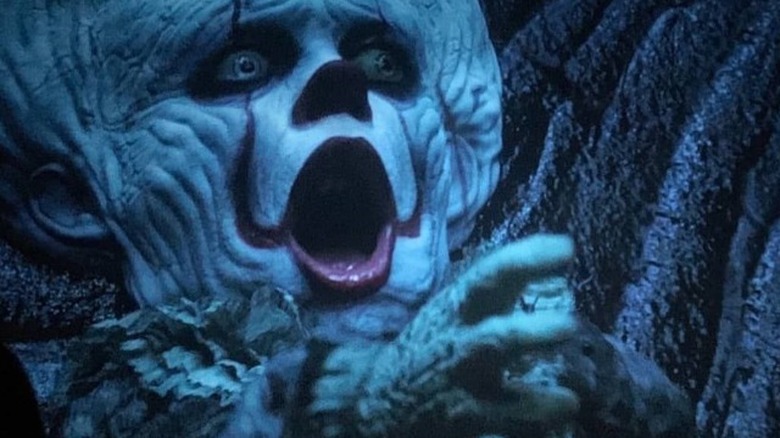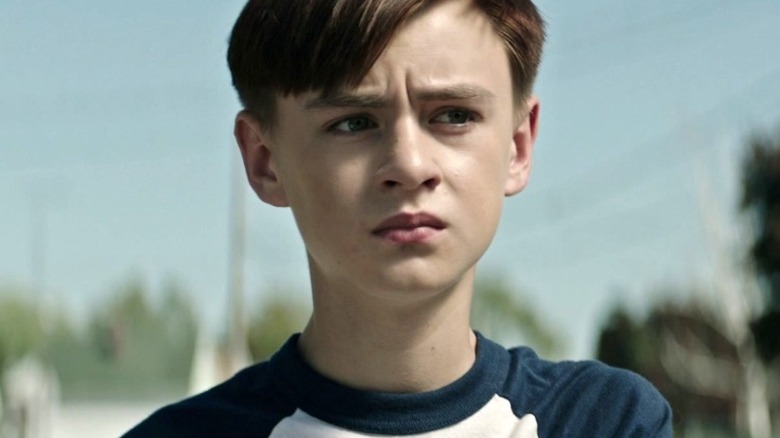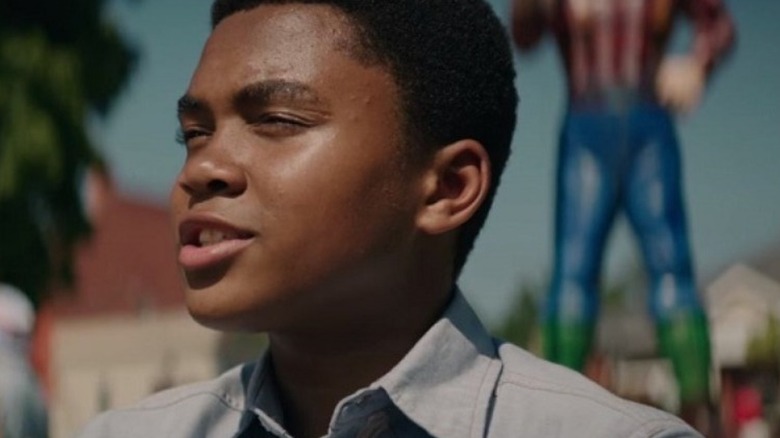The Biggest Unresolved Questions In The IT Franchise
Andy Muschietti's adaptation of Stephen King's classic novel was a masterclass in horror filmmaking. Long-considered King's most popular work, its first adaptation was Tommy Lee Wallace's made-for-tv version, mostly notable for Tim Curry's inimitable turn as the malicious cosmic entity Pennywise the Dancing Clown. While successful in spurts, it was Muschietti's 2017 feature, the first of two, that near-perfectly captured the essence of King's novel. Epic in scale and a financial powerhouse, "It: Chapter 1" is one of this century's keystone horror features.
Naturally, in adapting one of King's longest works — over 1,000 pages — several cuts had to me made translating the source material to screen. Notably, in both interviews with Collider and Esquire, director Andy Muschietti remarked on the cuts made to successfully adapt the material, namely eschewing some of the novel's more cosmic elements. Drenched in mythology and lore, the novel goes to some very strange places, not all of which would successfully translate to screen. Pennywise's cosmic origins, the Ritual of Chüd, and several other key elements were reduced, changed, or cut entirety. Resultantly, for as wonderful as both movies are, there are some nagging questions left unresolved. Though the novel answers some, the movies, absent of the novel's context, need to stand on their own, and answers to these 11 questions remain unclear.
11. Richie's Feelings for Eddie
"It: Chapter 2" is dense. Depending on one's tastes, it's either epic or interminable. Unlike the source material or Wallace's miniseries, Muschietti's adaptation, for the most part, splits the material into two distinct timelines — childhood and later adulthood. While there are flashbacks aplenty, "It: Chapter 2" is distinctly the now-grown Losers Club's story, and resultantly, there are new insights into their personal lives. In one of the most contentious changes from the book, Muschietti imbues Bill Hader's Richie Tozier with some conspicuous queer feelings toward fellow loser Eddie Kaspbrak (James Ransone).
While the representation is nice in broad terms, it's considerably misguided, with Bill Skarsgård's Pennywise repeatedly taunting both young (Finn Wolfhard) and adult Richie about his "secret," an abundantly clear crush on Eddie. What's worse is that, like the source material, Eddie is killed in the Club's final confrontation with Pennywise, rendering a tragic death even more tragic, in large part because while the heterosexual relationships cultivated persist, the one distinct queer element is quickly quelled. Eddie never learns how Richie felt toward him, and Richie — near inconsolable in the finale — is swiftly swept aside. Audiences never learn how this death affects him and whether he chooses to do anything on account of it. Does he plan to come out? Reveal his feelings to the other Losers? Audiences will never know, with Richie's feelings unfortunately consigned to "It: Chapter 2's" troubling cosmic closet.
10. Pennywise's Hold over Derry
In both "It: Chapter 1" and "It: Chapter 2," Muschietti grounds Pennywise's noxious hold over the town of Derry, Maine considerably better than Wallace did in 1990. When young Ben Hanscom (Jeremy Ray Taylor) is attacked and knifed by a group of bullies, a Pontiac rolls by, disinterested in getting intervening in some admittedly next-level adolescent bullying. The red Pennywise balloon that appears in the backseat is enough indication that evil flourishes in Derry because Pennywise lets it, with none of the adults strong or resolved enough to fight back. Pharmacists, parents, and even law enforcement are steadfastly held by Pennywise's chokehold, and resultantly, evil cultivates for decades.
Even "It: Chapter 2," in another considerably misguided scene, opens with a horrific hate crime rendered with more visceral violence than necessary. While mishandled, it nonetheless adroitly confirms that in the 27 years since the Losers Club first faced off against Pennywise, his grasp on Derry remains. Yet, it begs the question — does Derry ever come to terms with Pennywise's influence? After he is ultimately defeated, audiences are left wondering whether any repressed memories or awareness surfaces among those affected. Do the adults return to normal with reasonable cognizance of the tragedies that played out? Additionally, do those who survived encounters with Pennywise remember? It's left incredibly vague, which might prove frustrating, especially considering how central an element it was, especially in "Part 1."
9. Is IT really dead?
With a prequel series in development at HBO Max, it's clear the creative team behind both "It: Chapter 1" and "2" have no intention of letting Pennywise die. While a prequel series makes sense and is a longstanding tactic for milking every last dollar out of a franchise (see the "Star Wars" prequels), it compounds the nagging question several audience members had after finishing "It: Chapter 2." Is Pennywise really dead?
While the AV Club recounts some of the novel's more cosmic elements, and those do account for Pennywise truly being defeated, the movie series is considerably less clear. While the ostensibly happy ending of "Chapter 2" certainly suggests Pennywise's evil is contained, the sheer magnitude of his influence and power is hard to reconcile with his ultimate demise. In effect, the surviving members of the Losers Club bully Pennywise into submission before crushing his heart. It's symbolic, sure, but just 27 years prior, the Losers were fairly confident they'd defeated Pennywise. Who's to say, like before, Pennywise isn't simply biding his time for another 27 years. As a cosmic entity, it's hard to believe that a very human death would be enough to stop him.
8. Are there others like IT?
Less a question posed specifically by the movies and one that nags on the periphery, audiences might be left wondering whether Pennywise is the only entity of his kind on earth. Constrained in perspective to Derry, Maine for the most part, it's hard not to wonder whether Pennywise, or another version of him, has shown up anywhere else. A misguided belief in the preeminence of Western culture is the only thing that might suggest Pennywise was happy to settle in Derry and not expand his reach elsewhere.
"It: Chapter 2" does allude to Pennywise's arrival during the Ritual of Chüd where Pennywise is conceptualized as a glowing, hulking meteor crashing to earth where Derry would eventually be, though given how many of the cosmic elements are eschewed, it's unclear whether similar entities landed elsewhere. London, Melbourne, or Tokyo, among hundreds of other places, are no less ripe for a Pennywise-esque terror spree.
7. The Rock Fight
The rock fight in the quarry is a galvanizing moment in all three iterations of "It." In the novel, Wallace's adaptation, and Muschietti's, it's a moment that conceptualizes the Losers Club's strength and foreshadows their inevitable showdown with Pennywise in the sewers. It's about friendship and reliance and all that, sure, and it works incredibly well. Yet, for as successful as the scene is thematically, the practicality of it all is hanging by some pretty tenuous threads.
In Muschietti's adaptation especially, the Losers pelt rocks at a ragtag group of bullies to save Mike (Chosen Jacobs) from a pretty severe beating, all while Pennywise, snacking on a severed arm, watches from the sidelines. It's a fun scene and perfectly encapsulates Muschietti's tonal balance between comedy and horror, but some of the hits these kids take look brutal. These aren't pebbles—they're fully formed, hard, jagged rocks. As the rocks whiz by with the sound effects of speeding bullets, it's hard to question how every single participant walked away without more serious injuries. Henry Bowers (Nicholas Hamilton) gets it especially badly, yet several scenes later, he's back to menacing the Losers without nary a scratch.
6. Why Aren't the Kids Taken?
While "It: Chapter 1" was a critical success, noted for being wildly inventive and subversive within the horror genre, its overall structure is deceptively, brilliantly simple. With a large cast of Losers at its core, Muschietti fills the first half of "It" with vignettes of their disparate encounters with Pennywise. It's an opportunity for distinct scares, with some — such as Beverly's (Sophia Lillis) bloody sink—proving more visceral than others. In effect, Muschietti is able to tackle multiple horror subgenres within the same movie, ensuring his scare tactics never grow scale.
Wildly effective as it may be, though, it begs the perennial question — why didn't Pennywise kill any of these kids? Admittedly, their escape from his grasp is more happenstance than anything. In the aforementioned bloody sink scene, Beverly simply endures it. If Pennywise is capable of flooding her bathroom with blood, why not simply take and kill her then? The same goes for the other Losers. While the book posits Macroverse being Maturin, an interdimensional turtle, is responsible for their protection, the movie reduces him to a fun easter egg. Resultantly, it's never quite clear how Pennywise's power works, and why he easily snatches some kids and seems incapable of harming others.
5. Shaky Memory
A core component of both "It: Chapter 1" and "It: Chapter 2" is the power and efficacy of memory. The collective Losers make a blood oath at the conclusion of "Chapter 1," promising to return to Derry 27 years later if Pennywise proves to still be alive. Everyone agrees, though by the time "Chapter 2" rolls around and Mike Hanlon (Isaiah Mustafa) is calling the requisite Losers up, everyone seems to have forgotten. While that works, grounding the horrifying nature of their experience and the curative properties of leaving trauma behind, what doesn't is the arbitrary memory at the end of "Chapter 2."
If the Losers were incapable of remembering the events of "Chapter 1," it follows that, in time, the events of "Chapter 2" should be forgotten too. Only, they're not. Several characters posit that perhaps because the evil is destroyed, they'll be able to remember, despite the evil ostensibly being destroyed in "Chapter 1" as well. Additionally, Mike additionally contends that because the conclusion is a "good" memory, they'll be capable of remembering. The end of "Chapter 2" is no better or worse than "Chapter 1." It's not innately good in any sense, and it could be argued that it's worse. More people have died, including close friends and children in Derry, so it figures the trauma would be compounded, not assuaged. It might seem nitpicky, but with memory core to the inciting incidents of "Chapter 2," it's fair for audiences to question how, exactly, it all works.
4. Eddie's Death
Eddie Kaspbrak (James Ransone) is impaled by a giant, arachnid cosmic entity. While he very much endures a movie wound — a horrible injury he endures long enough for a final goodbye — he is pretty savagely killed by Pennywise. That's a hard sell, especially for the law enforcement officers, coworkers, and wife, Myra (Molly Atkinson, who also played Eddie's mother, Sonia in the first) who might wonder where the heck Eddie is.
Horror movies are wont to eschew the more procedural elements of their horrors, though "It" is especially egregious insofar as it ends on a conclusively happy note. The trauma of Richie, other friends, or Stanley (Andy Bean) — the Loser who took his own life — are ignored so that everyone can end with a smile on their face. Yet, as the cavern where their final battle took place implodes, the Losers are forced to leave Eddie's body behind. What do they say? Do they suggest he's simply missing? While that would help to shield them from hard questions, it precludes Eddie from the burial he deserves. His legacy is ignored and it leaves a sour taste in the audiences' mouths.
3. Does Anyone Else Know IT?
Audiences might be left wondering whether anyone else remembers Pennywise within the boundaries of Derry itself. "It: Chapter 2" features not just one, but two distinct adolescent deaths. Much like the antecedent Losers, audiences might wonder whether these kids had a de facto club of their own, one characterized by hushed tones and muted whispers of the killer clown everyone has seen.
While it tracks that those ancillary players — grieving parents and school teachers — might not remember the full extent of Pennywise's grip once he's defeated, if the Losers remember, it follows that other survivors would as well. That would mean there's an entire classroom of young people who know about Pennywise. Worse still, their only confirmation he's been defeated might very well be his absence. With no definitive proof, they might note how Pennywise simply isn't showing up anymore. "It: Chapter 2" went to great lengths to expand the reach of Pennywise's threat, though in its concluding moments, it all but ignores the full impact on Derry, Maine.
2. What Happened to Bill's Parents?
"It: Chapter 1" doesn't especially paint Bill Denbrough's (Jaeden Martell) parents in the best light. Instead of recognizing their overwhelming grief and the insinuation Pennywise is influencing their myopia, they're simply obstacles for Bill to overcome as he endeavors to find out what happened to his younger brother, Georgie (Jackson Robert Scott). Spoiler, Bill — Pennywise bit his arm off and dragged him into the sewers.
Given how thematically crucial their presence in the first was, though, it's strange that they're absent in "Chapter 2." There is no concluding arc for them. While it is the Losers Club's story, no doubt, it's odd that Bill (James McAvoy) has conceptualized Georgie as his brother and his brother alone. Not a son or friend, but simply a person who exists exclusively in relation to him. As a successful novelist living in Los Angeles, adult Bill should, at least in theory, be more connected to his past, especially his two parents who lost a son of their own. It's an odd omission that highlights the folly in expanding a universe a bit too far.
1. Why Isn't Mike Hanlon Given More to Do?
In Stephen King's book, Mike Hanlon is the last of the Losers Club to join. Additionally, his upbringing is considerably more stable, and less replete with abuse, than the other losers. Yet, the adolescent thread of King's original is set in the 1950s, and Mike is resultantly the victim of violent, racist bullying. The racial trauma he endures in considerably more implicit in Muschiettis' adaptation, in part because of the shift from the 1950s to the 1980s, though as a result, Hanlon is a more implicit character as well. Hanlon is the only character who has first-person narration in King's novel, the only character to stay behind in Derry, and the only character who figures out how to stop Pennywise, yet in both "Chapter 1" and "Chapter 2," he is given nothing to do.
It's especially egregious on account of Hanlon being the only central black character in the story, and Jack Hamilton, writing for Slate, adroitly details how several other shifts in characterization do a disservice to a beloved character. In effect, the filmmakers don't know what to do with Mike, so he is consigned to an expository talking head, a means to get from one point to another, without any of the required depth or immediacy as other characters. It's a genuine shame, and for audiences familiar with the original book, poses a genuinely troubling question; how can a filmmaker not recognize how crucial a character Mike Hanlon is?
